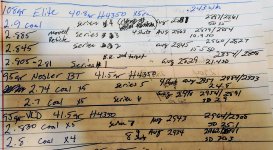Lots, but only one that really matters, which is that your rifle, ammo, shooting conditions, and results are unique to you and the day you shot them.
There are a huge number of factors involved in the velocities your chronograph displays, which can even include the angle and strength of the light and how you hold the gun when firing.
No computer program can account for all the variables, no matter how many data points it allows you to enter, the programs must rely on certain constants that may, or may not be precisely what your factors are.
You seem to be expecting precision from a system designed to give general guidelines, and that nearly always leads to some level of disappointment or frustration.
What you have is one example of an observed trend. You're shooting loads in excess of industry standard max loaded length. You did it once, and noted
slightly different speeds for different seating depths.
Do it again, as close to exactly duplicating what you did before and see if you get similar results. Then do it a few more times. IF your results show a consistent, repeatable pattern, then you have data. But, it is data specific to your gun, your loads, your shooting, and your conditions at the time.
And when variations are only a handful of fps its tought to say what factor, or combinations of factory might be the likely cause.
Just for example, did you consider the differences in seating depth might change the amount of tension holding the bullet in the case, and that different might accout for 20,30, 50, 60 +/- fps ??
OR perhape the slightly different amount of space in the case due to different bullet seating depths changing the amount of pressure? OR both factors together, and possibly several others also, all at the same time??
I think you're concerned with how many angels are dancing on the head of your pin, and wondering why a computer program doesn't tell you its 19 or 17 when you can see there is a difference...
Good luck with your quest, but other than "when you make a change, you get a change", I've got no specific help, only possibly things that neither of us can know, or prove with certainty.


